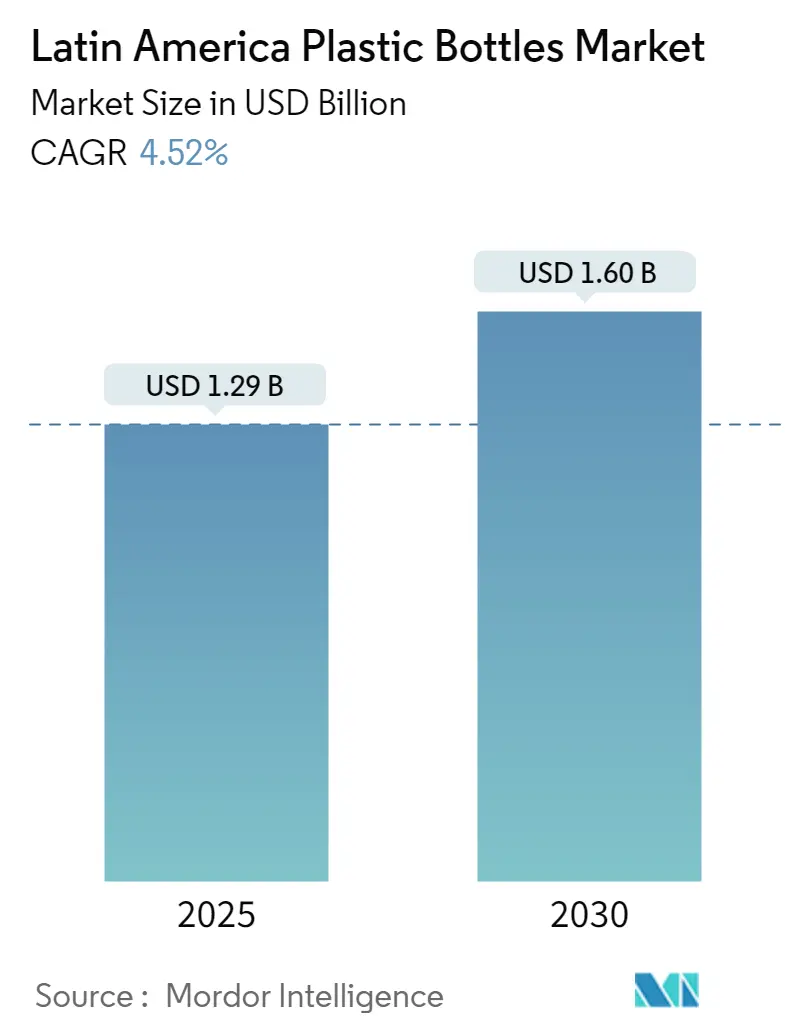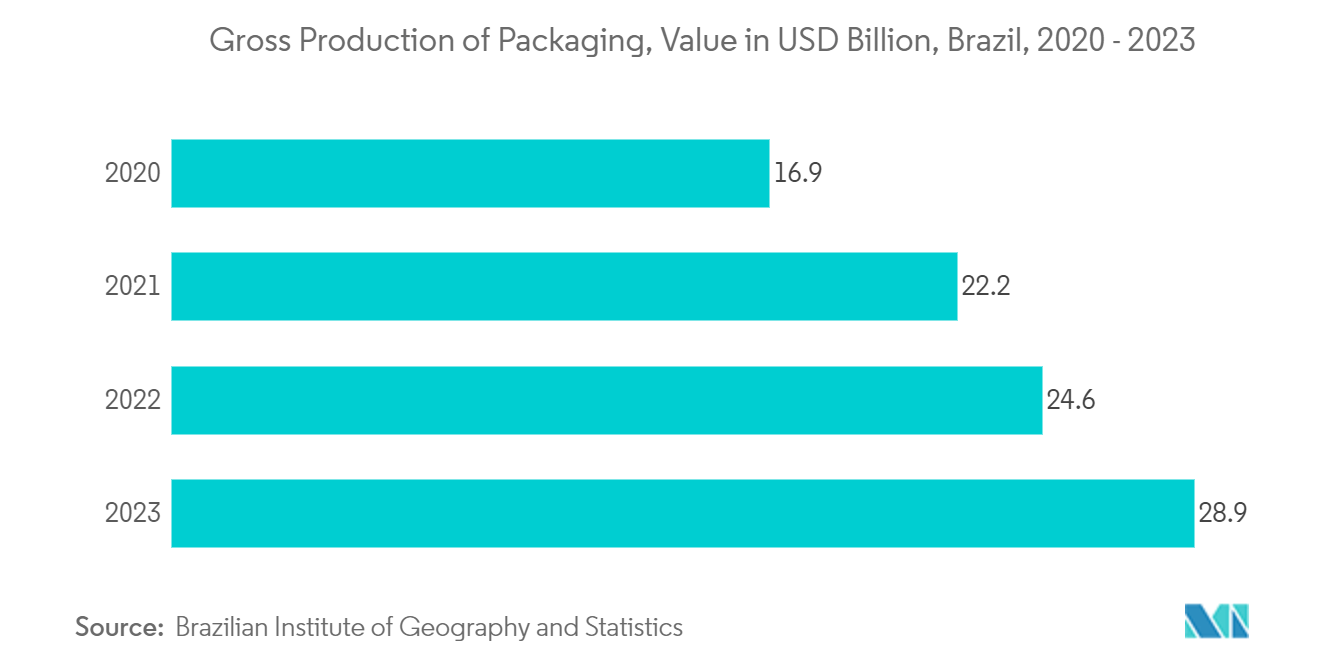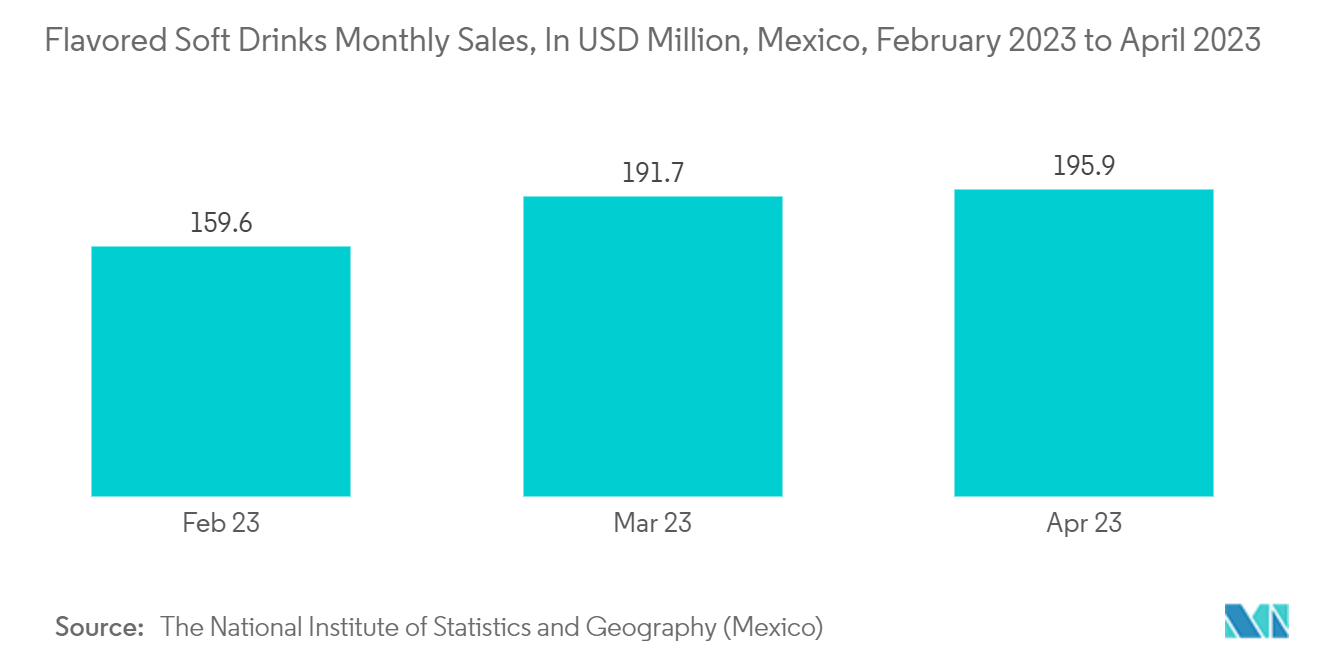Latin America Plastic Bottles Market Analysis
The Latin America Plastic Bottles Market size is worth USD 1.29 Billion in 2025, growing at an 4.52% CAGR and is forecast to hit USD 1.60 Billion by 2030.
- Plastic bottles and containers, primarily made of polyethylene terephthalate, polypropylene, and polyethylene, are widely used due to their lightweight and durable nature, which enhances handling efficiency. Manufacturers prefer plastic packaging for its lower production costs. The plastic bottles market in Latin America is expected to grow during the forecast period, driven by the cost-effectiveness of plastic packaging and the increasing consumption of packaged and processed foods and beverages.
- Plastic packaging has become increasingly popular among Latin American consumers due to its lightweight and durable nature, which enhances ease of handling and transportation. Manufacturers favor plastic packaging due to its cost-effective production and versatile design options. The introduction of advanced polymers such as polyethylene terephthalate (PET) and high-density polyethylene (HDPE) has expanded applications for plastic bottles across food and beverage, personal care, and household product industries. The market has seen increased demand for PET bottles, driven by their recyclability, clarity, and barrier properties. This trend is supported by growing consumer awareness of environmental issues and demand for sustainable packaging solutions.
- Plastic bottles and containers are manufactured using various raw plastic materials, with polyethylene terephthalate (PET) being the primary choice due to its durability, versatility, and cost-effectiveness. As end-user industries such as food, beverage, and pharmaceuticals expand and innovate, the demand for plastic bottles and container packaging increases. This growth is driven by changing consumer preferences, urbanization, and the need for convenient packaging solutions. In particular, the food and beverage industry has seen a significant rise in plastic bottles and containers for products ranging from soft drinks and water to sauces and condiments. In the pharmaceutical industry, plastic containers are increasingly used for medication packaging, ensuring product safety and extending shelf life.
- The introduction of new beverages with different flavors and packaging formats in the industry continues to drive the need for rigid plastic bottles. The cosmetics and personal care industry also contributes to the demand, utilizing plastic bottles for products like shampoos, lotions, and creams. As these industries continue to evolve and adapt to consumer needs, the plastic bottle and container market is expected to grow in tandem, offering opportunities for innovation in design, sustainability, and functionality.
- Due to its unique properties, the pharmaceutical industry in Latin America has seen increased demand for plastic packaging. Key features driving adoption include moisture barrier, dimensional stability, impact strength, strain resistance, low water absorption, transparency, heat and flame resistance, and extended product shelf life. These attributes make plastic packaging particularly suitable for protecting and preserving pharmaceutical products.
- The increase in plastic pollution across Latin America has prompted governments to implement policies to reduce plastic waste and promote sustainable packaging solutions. These measures have, to some extent, constrained the market in the region. Plastic has significantly contributed to environmental degradation, and awareness of its effects has grown among users and throughout the industry ecosystem. Governments have conducted numerous public campaigns and initiatives to raise awareness. As concerns about plastic pollution continue to rise, manufacturers and consumers increasingly gravitate toward alternative packaging materials that offer environment-friendly properties and innovative solutions.
- For instance, Valgroup, one of the largest plastic producers, processors, and recyclers in Latin America, acquired the PET bottle recycling operations of 3 Rios Fibras e Resinas in Poços de Caldas, Minas Gerais. The company is investing in expansion, increasing its installed capacity for producing food-grade rPET (recycled PET resin). This recycling process, known as bottle-to-bottle, transforms post-consumer PET bottles into new ones ready for filling. Valgroup's PET recycling plants in Brazil, Mexico, and Spain collectively process 145,000 tons of post-consumption recycled resin annually.
Latin America Plastic Bottles Market Trends
The Polyethylene Terephthalate (PET) Segment to Hold Significant Market Share
- PET has become a crucial packaging material for bottle manufacturers across the country. Lightweight PET resins with high strength, toughness, good abrasion and heat resistance, low creep at elevated temperatures, and good chemical resistance make them ideal for bottle and container production.
- These properties contribute to the durability and versatility of PET packaging, making it suitable for various products, including beverages, food items, and personal care products. PET's recyclability and cost-effectiveness further enhance its appeal to manufacturers, aligning with growing consumer demand for sustainable packaging solutions. As a result, PET continues to dominate the packaging industry, driving innovation and efficiency in bottle and container production.
- The trend toward lightweight products is cost-effective and helps manufacturers gain a competitive advantage in the market. This shift toward lighter packaging materials, particularly plastic bottles, allows companies to reduce production costs and transportation expenses. In 2023, the gross production value of Brazil's packaging industry was estimated at USD 28.9 billion, an increase from USD 22.2 billion in 2021.
- This significant growth of approximately 30% over two years highlights Brazil's expanding packaging solutions market. The rising demand for packaging and the trend toward lightweight products present substantial opportunities for plastic bottle manufacturers in the coming years. As consumers and businesses increasingly prioritize sustainability and cost-efficiency, manufacturers who can provide lightweight, durable plastic bottle solutions are expected to see increased demand for their products.
- Sustainable packaging solutions have gained prominence due to increased consumer awareness of their environmental benefits. This trend has shifted consumer preferences toward products using eco-friendly packaging materials. Companies across industries have responded by investing in research and development of sustainable packaging options. PET has emerged as a critical resin in eco-friendly packaging due to its recyclability and potential for circular use. Its versatility allows for applications in various packaging formats, from bottles to food containers. PET's recyclability reduces plastic waste and conserves resources, aligning with the growing global focus on sustainability and circular economy principles.
Carbonated Soft Drinks Expected to Hold Significant Share in the Market
- PET is the most popular plastic packaging material for soft drinks. PET bottles must be solid to withstand the internal pressure of CO2 without distortion or expansion. Soft drink manufacturers are increasingly choosing plastic containers due to several factors influencing packaging design for carbonated beverages. PET bottles are more energy-efficient than glass bottles in delivering 1,000 gallons of soft drinks and generate less solid waste by weight compared to glass and aluminum containers. Consequently, companies are transitioning to PET formats for carbonated beverages and innovating with recycled materials in response to changing consumer preferences in the country.
- Due to factors such as a hot and humid climate, changing demographics, increasing spending power among the youth, rapid urbanization, and a rise in rural consumption, the demand for carbonated soft drinks in the country is adapting. In April 2023, sales of flavored soft drinks in Mexico exceeded USD 195.9 million, a notable increase from approximately USD 159.6 million in February 2023. This surge underscores the region's growing appetite for soft drinks, subsequently driving the demand for plastic bottle packaging. Packaging for carbonated drinks requires containers that endure pressure without altering the flavor.
- However, there has been a notable shift toward plastic packaging in recent years. This change is primarily attributed to the challenges posed by glass bottles, including their reusability costs for manufacturers and the risk of breakage and damage during transit. Additionally, plastic bottles offer advantages such as lighter weight, lower transportation costs, and greater convenience for consumers, further fueling their adoption in the market. The transition to plastic packaging also aligns with the increasing emphasis on sustainability as manufacturers explore recyclable and eco-friendly plastic options to meet environmental regulations and consumer preferences.
- The globalization of consumers is a critical factor in the soft drinks industry's success. Advancements in technology and transportation have allowed companies to access global markets, creating new growth opportunities. Multinational soft drink brands have leveraged this trend by forming partnerships with regional bottlers and distributors. These collaborations with local market experts enable faster expansion into new territories, altering consumption patterns and plastic bottle demand across regions.
Latin America Plastic Bottles Industry Overview
The Latin American plastic bottles market is fragmented, with several global and regional players, such as ALPLA Group, Amcor Group, and Enka de Colombia, vying for attention in a contested market space. This market is characterized by low product differentiation, growing levels of product penetration, and high levels of competition.
- May 2024 - ALPLA, a specialist in plastic packaging, introduced a safe, affordable, and sustainable recyclable PET wine bottle. Weighing just an eighth of a traditional glass bottle, this innovation can cut the carbon footprint by as much as 50% and offers potential cost savings of up to 30%. The bottle can be produced entirely from recycled PET (rPET). The packaging solution is currently available in 0.75 L and 1 L sizes.
- April 2024 - Amcor, a global player in packaging solutions, unveiled a 1 L carbonated soft drink (CSD) bottle crafted entirely from post-consumer recycled (PCR) polyethylene terephthalate (PET) material.
Latin America Plastic Bottles Market Leaders
-
Amcor Group
-
Sidel Group
-
Berry Global Inc.
-
Graham Packaging
-
Indorama Ventures Public Company Limited.
- *Disclaimer: Major Players sorted in no particular order
Latin America Plastic Bottles Market News
- November 2023 -Sidel's new PET bottle, designed for liquid dairy manufacturers, offers increased competitive advantages. This mini-size bottle, ranging from 65 ml to 150 ml, is suitable for products like drinking and probiotic yogurts. It is compatible with both ambient and cold chain processes. The bottle design also accommodates applications in the juice, nectar, soft drinks, isotonic, and tea markets.
- August 2023 - Indorama Ventures Public Company Limited, a leading global producer of recycled polyethylene terephthalate (PET) resin, completed the expansion of its recycling facility in Brazil. The project was supported by a 'Blue Loan' from the International Finance Corporation (IFC), a World Bank member. Located in Juiz de Fora, Minas Gerais, the facility increased its annual production capacity of post-consumer recycled PET (PET-PCR) from 9,000 tons to 25,000 tons. This expansion aligns with Indorama Ventures' Vision 2030 strategy to build a sustainable global company, which includes a USD 1.5 billion investment to increase its recycling capacity to 50 billion PET bottles annually by 2025.
Latin America Plastic Bottles Industry Segmentation
The scope of the study characterizes the plastic bottles market based on the raw materials of the product, such as PP, PE, PET, and other raw materials, used across various end-use industries such as food, pharmaceuticals, beverages, cosmetics, and toiletries across multiple countries. The research also examines underlying growth influencers and significant industry vendors, all of which help to support market estimates and growth rates throughout the anticipated period. The market estimates and projections are based on the base year factors and arrived at top-down and bottom-up approaches.
The Latin American plastic bottles market is segmented by resin (polyethylene (PE), polyethylene terephthalate (PET), polypropylene (PP), and other resins), end-use industries (food, beverage [bottled water, carbonated soft drinks, alcoholic beverages, juices and energy drinks and other beverages (powdered and dairy-based beverages)], pharmaceuticals, personal care and toiletries, household chemicals, paints and coatings, and other end-use industries), and country (Brazil, Mexico, Columbia, and Rest of Latin America). The market sizes and forecasts are provided in terms of value (USD) and volume (tonnes) for all the above segments.
| By Resin | Polyethylene (PE) | ||
| Polyethylene Terephthalate (PET) | |||
| Polypropylene (PP) | |||
| Other Resins | |||
| By End-use Industries | Food | ||
| Beverage | Bottled Water | ||
| Carbonated Soft Drinks | |||
| Alcoholic Beverages | |||
| Juices and Energy Drinks | |||
| Other Beverages (Powdered and Dairy-based Beverages) | |||
| Pharmaceuticals | |||
| Personal Care and Toiletries | |||
| Industrial | |||
| Household Chemicals | |||
| Paints and Coatings | |||
| Other End-use Industries | |||
| By Country*** | Brazil | ||
| Mexico | |||
| Colombia | |||
Latin America Plastic Bottles Market Research FAQs
How big is the Latin America Plastic Bottles Market?
The Latin America Plastic Bottles Market size is worth USD 1.29 billion in 2025, growing at an 4.52% CAGR and is forecast to hit USD 1.60 billion by 2030.
What is the current Latin America Plastic Bottles Market size?
In 2025, the Latin America Plastic Bottles Market size is expected to reach USD 1.29 billion.
Who are the key players in Latin America Plastic Bottles Market?
Amcor Group, Sidel Group, Berry Global Inc., Graham Packaging and Indorama Ventures Public Company Limited. are the major companies operating in the Latin America Plastic Bottles Market.
What years does this Latin America Plastic Bottles Market cover, and what was the market size in 2024?
In 2024, the Latin America Plastic Bottles Market size was estimated at USD 1.23 billion. The report covers the Latin America Plastic Bottles Market historical market size for years: 2019, 2020, 2021, 2022, 2023 and 2024. The report also forecasts the Latin America Plastic Bottles Market size for years: 2025, 2026, 2027, 2028, 2029 and 2030.
Latin America Plastic Bottles Industry Report
Statistics for the 2025 Latin America Plastic Bottles market share, size and revenue growth rate, created by Mordor Intelligence™ Industry Reports. Latin America Plastic Bottles analysis includes a market forecast outlook for 2025 to 2030 and historical overview. Get a sample of this industry analysis as a free report PDF download.

.webp)



.webp)

